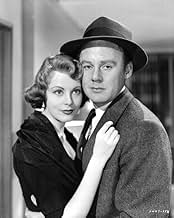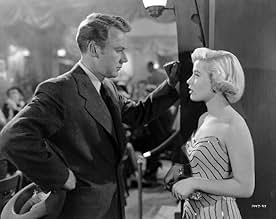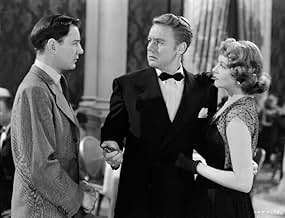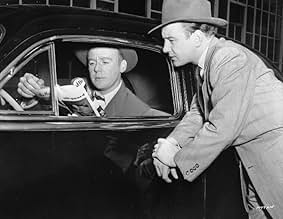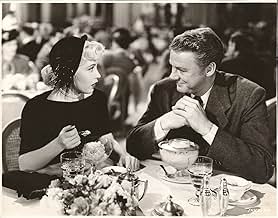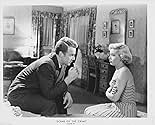ÉVALUATION IMDb
6,6/10
1,6 k
MA NOTE
Ajouter une intrigue dans votre langueWhile his wife is urging him to quit the force, a Los Angeles homicide detective hunts for the killer responsible for the murder of his ex-partner, who might have been on the take with local... Tout lireWhile his wife is urging him to quit the force, a Los Angeles homicide detective hunts for the killer responsible for the murder of his ex-partner, who might have been on the take with local bookies.While his wife is urging him to quit the force, a Los Angeles homicide detective hunts for the killer responsible for the murder of his ex-partner, who might have been on the take with local bookies.
- Director
- Writers
- Stars
- Prix
- 1 nomination au total
Gloria DeHaven
- Lili
- (as Gloria De Haven)
Bette Arlen
- Girl with Sleeper
- (uncredited)
Avis en vedette
An off-duty Los Angeles police detective is shot and killed one night with an unexplained thousand dollars found in his pocket. It falls to his former partner (Van Johnson) to track down his killers and try to exonerate him. Scene of the Crime, which tells the story, stays a police procedural with a few twists and touches that raise it a notch or two above the routine.
First of all, Johnson's wife (Arlene Dahl) has fallen prey to the dissatisfactions common to her lot. She's tired of their evenings, in and out, being ruined by yet another summons to duty (`Whenever the telephone rings, it cuts me,' she cries); she tired of rolling his dice rigged to come up seven, a ritual that supposedly bids him luck.
On the job, he has his burdens, too. His new partner (John McIntyre) is getting on in years and his sight is failing. And under Johnson's wing is nestled rookie cop Tom Drake, learning the ropes. Outside the office there's an abrasive police reporter (Donald Woods) chasing the corruption angle; there's also the network of low-lifes who serve, if the pressure is right, as stoolies - most vivid of them is the young Norman Lloyd.
Word filters up that the killing was the work of a couple of downstate `lobos' who have been knocking over bookie operations. Going undercover, Johnson starts romancing a stripper one of them used to date (Gloria De Haven, in the movie's sharpest performance). Even though he's working her, he finds his emotions in play - and even though it turns out that she's working him, too, she has no emotions.
Under Roy Rowland's direction, Scene of the Crime keeps its plotting straightforward, though with some uncharacteristic bursts of violence. The movie's studio, Metro-Goldwyn-Mayer, was celebrated for its lavish color musicals, not for the unsentimental style of film noir. That probably accounts for the final shot's being a reconciliatory kiss, in hopes that such a sweet image might expunge all the urban squalor that went before it. Luckily, it doesn't.
First of all, Johnson's wife (Arlene Dahl) has fallen prey to the dissatisfactions common to her lot. She's tired of their evenings, in and out, being ruined by yet another summons to duty (`Whenever the telephone rings, it cuts me,' she cries); she tired of rolling his dice rigged to come up seven, a ritual that supposedly bids him luck.
On the job, he has his burdens, too. His new partner (John McIntyre) is getting on in years and his sight is failing. And under Johnson's wing is nestled rookie cop Tom Drake, learning the ropes. Outside the office there's an abrasive police reporter (Donald Woods) chasing the corruption angle; there's also the network of low-lifes who serve, if the pressure is right, as stoolies - most vivid of them is the young Norman Lloyd.
Word filters up that the killing was the work of a couple of downstate `lobos' who have been knocking over bookie operations. Going undercover, Johnson starts romancing a stripper one of them used to date (Gloria De Haven, in the movie's sharpest performance). Even though he's working her, he finds his emotions in play - and even though it turns out that she's working him, too, she has no emotions.
Under Roy Rowland's direction, Scene of the Crime keeps its plotting straightforward, though with some uncharacteristic bursts of violence. The movie's studio, Metro-Goldwyn-Mayer, was celebrated for its lavish color musicals, not for the unsentimental style of film noir. That probably accounts for the final shot's being a reconciliatory kiss, in hopes that such a sweet image might expunge all the urban squalor that went before it. Luckily, it doesn't.
An LA police detective (Van Johnson) investigates the murder of another detective and gets involved with night club singer and stripper played by Gloria De Haven. The story has a neat double cross. A criminal organization from "down south" sends a couple of "lobos" to LA in order to take over a bookmaking syndicate. Corruption is at the center of the story as the dead detective was carrying a wad of cash. Johnson's out to prove that he (dead detective) wasn't on the take. His street contact Sleepy (Norman Lloyd) provides some of the films more vivid moments, and Jerome Cowan (Sam Spade's partner in Maltese Falcon) has a great part as "fixer" Arthur Webson. Johnson does very well in the part, combining breeziness that he honed in earlier films with sufficient grit to be believable as a tough detective. His wife played by Arlene Dahl looks great and they share some pretty good chemistry in their scenes. The film does a good job of capturing the story's different elements and cohesively combining them. The action doesn't always come, but when it does it is surprisingly sudden and brutal for the times.
Did, as some people think, "Scene of the Crime" invent the cop drama clichés that have been a mainstay of television and film for so long? Or were they already established and just copied by this film? Not being an expert in the genre, I don't know. I do know that despite attempts by some people to elevate this movie to film noir status, it's not that great. Dore Schary put this into production when he took over MGM. I guess he wanted MGM to be more like Warner Brothers. It stars Van Johnson, Arlene Dahl, John McIntyre, Leon Ames, and Gloria DeHaven.
When a cop is killed with a roll of dough found on him, his fellow officers set out to investigate the crime and clear the man's name.
"Scene of the Crime" is similar in its way to "Dragnet" - it shows the daily grind of detectives as they put together a case. There are a couple of very good scenes, including one in which Mike (Van Johnson) arrests a suspect, and shooting starts when they get outside of the apartment building. Still handcuffed to Mike, the perp jumps into a building stairwell. There's also a good car chase.
For some reason, Van Johnson did these baby-faced tough guys well - perhaps it was his New York accent, but he pulls off the role of the dedicated Mike. He was set to be Elliot Ness in the TV "Untouchables" when his wife Evie called Desi Arnaz the night before and held him up for more money. Arnaz called Robert Stack and told him to report to the set the next day. A friend of mine who has lived in LA for over 50 years and socialized with many stars said that Arlene Dahl was the most beautiful woman of everyone he had met. Seeing her in this, you can believe it. She is a spectacular beauty if her acting in some spots isn't the best. Gloria De Haven, usually a vibrant ingenue, plays against type as a tramp, which makes it interesting.
"Scene of the Crime" is gritty-looking enough but suffers from being slow in spots and loaded with clichés. There isn't anything to make it truly special. That could be because by now, we've seen it all before. Perhaps in 1949, it was fresh. But I have my doubts that even back then, it broke any new ground.
When a cop is killed with a roll of dough found on him, his fellow officers set out to investigate the crime and clear the man's name.
"Scene of the Crime" is similar in its way to "Dragnet" - it shows the daily grind of detectives as they put together a case. There are a couple of very good scenes, including one in which Mike (Van Johnson) arrests a suspect, and shooting starts when they get outside of the apartment building. Still handcuffed to Mike, the perp jumps into a building stairwell. There's also a good car chase.
For some reason, Van Johnson did these baby-faced tough guys well - perhaps it was his New York accent, but he pulls off the role of the dedicated Mike. He was set to be Elliot Ness in the TV "Untouchables" when his wife Evie called Desi Arnaz the night before and held him up for more money. Arnaz called Robert Stack and told him to report to the set the next day. A friend of mine who has lived in LA for over 50 years and socialized with many stars said that Arlene Dahl was the most beautiful woman of everyone he had met. Seeing her in this, you can believe it. She is a spectacular beauty if her acting in some spots isn't the best. Gloria De Haven, usually a vibrant ingenue, plays against type as a tramp, which makes it interesting.
"Scene of the Crime" is gritty-looking enough but suffers from being slow in spots and loaded with clichés. There isn't anything to make it truly special. That could be because by now, we've seen it all before. Perhaps in 1949, it was fresh. But I have my doubts that even back then, it broke any new ground.
This is a very entertaining look at big city cops and robbers with shades of film noir showing though. The standout performance in a potentially femme fatale role is Gloria DeHaven. I suspect the writers, John Bartlow Martin and Charles Schnee, along with director Roy Rowland, had experiences with untrustworthy women, for Lili (Gloria DeHaven) could turn any man's heart to putty, then fool him over and over. Van Johnson too turns in a subdued performance which is called for in the character (Mike Conovan) he plays. Conovan's very liberal wife, especially for 1949, is played by Arlene Dahl, who is fed up with the demands of her husband's job but who also trusts her husband to be with a vixen and still stay true to her. This is an effective counterbalance to the untrustworthiness of Lili. Great supporting roles abound filled with standout performances from John McIntire's "too old to cut the mustard" part all the way to the Sleeper, Norman Lloyd. Yuk, Yuk, it's great. There is a lot of realistic blood and guts thrown in complete with car chases that foretell things to come in action movies. Heat up some popcorn, get a cold one, then sit back and enjoy the ride.
Two veteran Los Angeles police detectives and a well-meaning rookie set out to find the killer of an off-duty fellow officer who may have been on the take. This is an L.A. filled with dangerous broads, bookie joints, ex-bootleggers in on a new racket, and cops in natty suits and broad-billed hats. The pulpy, slangy dialogue is fun at times, as are the performances from Van Johnson and Gloria DeHaven (playing a chanteuse "with a figure like champagne and a heart like the cork"). Other, later crime-dramas would quickly up the ante on such a scenario, but this one is a fine example of the compact policer. M-G-M was downsizing their budgets at the time and trying their hand at different types of films--which provided the perfect opportunity for matinée idols like Johnson to stretch their acting muscles. The results here are not exactly noir, but more from an overtly-ordinary, overtly-jaded mold, with everyday people going about their business and getting the job done. If it isn't exciting, at least it's highly competent. **1/2 from ****
Le saviez-vous
- AnecdotesThis film has many actors cast against previous types. Van Johnson had appeared in light comedies and musicals, making him a teen idol at the time. His versatility, proven in this film, would lead to his role in Bastogne (1949). Gloria DeHaven has previously been cast as sweet, innocent girls, but here she is a stripper and gun moll. Gorgeous Arlene Dahl, formerly a high-paid covergirl before marrying Mike, spurns the glamorous life and tries hard to accept the role the stay-at-home wife of a cop (whom she is desperately in love with, and daily fears losing).
- GaffesWhen Detective Piper introduces the young man that sold the .38 S&W revolver to the cop killer to detective Conovan the man says he sold the gun to a man in a bar. Conovan then assails the man over his getting a lousy eighty bucks for the gun that killed his former partner - lousy in what became of the gun, not the price, easily twice what the gun was worth. But at no time did the man or Piper mention getting that amount for the gun. It appears Piper had already reported in by phone, perhaps via CC, as Conovan did not register the least surprise at him appearing at the headquarters with the former gun owner in tow. And Conovan acted as though he already was familiar with the gist of the pickup, and was on edge and ready to talk hostilely to the young man, even threaten unlawful activities toward him.
- Citations
Sleeper: Naturally, I know you know I know somethin'.
Mike Conovan: I know you know I know you know somethin'.
- ConnexionsFeatured in Some of the Best: Twenty-Five Years of Motion Picture Leadership (1949)
- Bandes originalesI'M A GOODY-GOODY GIRL
(uncredited)
Music by André Previn
Lyrics by William Katz
Sung (with partial striptease) by Jean Carter
Meilleurs choix
Connectez-vous pour évaluer et surveiller les recommandations personnalisées
- How long is Scene of the Crime?Propulsé par Alexa
Détails
- Date de sortie
- Pays d’origine
- Langue
- Aussi connu sous le nom de
- La ciudad del crimen
- Lieux de tournage
- 259 E. 5th Street, Los Angeles, Californie, États-Unis(site of Hippo's Coffee Pot)
- société de production
- Consultez plus de crédits d'entreprise sur IMDbPro
Box-office
- Budget
- 761 000 $ US (estimation)
- Durée1 heure 34 minutes
- Couleur
- Rapport de forme
- 1.37 : 1
Contribuer à cette page
Suggérer une modification ou ajouter du contenu manquant

Lacune principale
By what name was Scene of the Crime (1949) officially released in India in English?
Répondre


